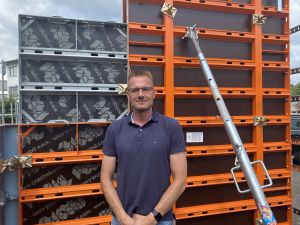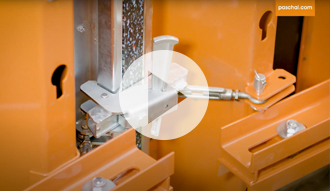“High-speed formwork”: with clamps instead of bolts
Formwork for the internal core of a potable water tank for the Schönewörde Waterworks was able to be carried out in a very short period of time thanks to the Circular Trapezoidal girder formwork with clamp connection from Paschal.Paschal was commissioned in May, and the panel elements that were handcrafted in the company headquarters in the Black Forest were delivered on the 5th of June. The order size was approximately 150,000 euros. The overall order size for the construction of the potable water tank was around 1.8 million euros.

Mathias Müller, specialist formwork consultant in the Paschal office in Gifhorn, Germany
Two semi-circles – two steps
The inner core of the potable water tank that was to be formed was planned and carried out in two formwork sections. In total, the formwork area to be concreted measured 320 square metres. As there were two sections, Gruska Baugeschäft only had to rent formwork panel elements for 160 square metres –
a cost-effective solution. Specialist formwork consultant Mathias Müller explains: "First, one semi-circle was formed and concreted. Then the formwork was moved and the second semi-circle was formed. The two concrete sections were then connected to each other. The customer needed less formwork, which was beneficial in terms of costs."
2 minutes instead of 15:
Rapid assembly thanks to the clamp connection
The formwork for one semi-circle consisted of seven individual segments that were further raised to reach an overall height of 4.50 metres. The great advantage of TTK: The individual panel elements can be put together more quickly thanks to the clamps.
“With the previous circular formwork, you needed 15 bolts to connect two formwork panels with a height of 450 cm with each other. Now, you only have to place four clamps and you don’t need to thread any bolts into holes any more.” says Mathias Müller. To put it more simply: “Hit it with a hammer and you’re done!” Axel Gruska also confirmed that placing the clamps was fast. The clamp connections allowed four employees of the construction company to set up the formwork segments for one section in two days. Or, to put it differently: If it took you around 15 minutes to place the bolts to connect two formwork segments with each other, it will now only take you about two minutes.

The Gruska Baugeschäft construction company building a potable water tank in the Schönewörde waterworks for the Gifhorn Water Board. It was possible to reduce forming and dismantling periods thanks to the Circular Trapezoidal girder formwork with clamp connection from Paschal.
No readjustment required
The radius of a circular object that is to be formed can be preset down to the exact centimetre using TTK. The edges of the formwork were pre-rounded for Gruska Baugeschäft in the Gifhorn branch. “This is also included in our service package” says Müller, adding: “The employees only had to set it up and assemble it in the waterworks. Otherwise, one of them might differ by half a centimetre during manual production of the wooden elements.” Foreman Jan Müller confirmed that “everything fitted perfectly first time.” No readjustment was needed in this case.
Mr Müller’s colleague in the Paschal office in Gifhorn was responsible for designing the formwork. Iwan Weber created it based on formwork plan from the Scholz engineering firm in Brunswick. Once the formwork had been delivered, Mathias Müller was on site personally and gave Jan Müller instructions and tips on handling the formwork: for example, he explained how many clamps were to be attached at height in order to avoid vertical deflections.
The construction company also benefited from short transport distances as a result of the proximity to each other. The formwork was in use for three weeks in total, shorter than expected. The professional support is also a factor. “Mr Müller is an excellent consultant who can communicate everything on the construction site in a way that is easy to understand and that ensures everything works”, says Axel Gruska.
 The formwork was delivered from the Gifhorn branch preset precisely for the radius required and ready-to-install; the seven individual segments of the formwork were raised to a total height of 4.50 metres. They are connected using clamps instead of bolts, and doing this is quick and easy.
The formwork was delivered from the Gifhorn branch preset precisely for the radius required and ready-to-install; the seven individual segments of the formwork were raised to a total height of 4.50 metres. They are connected using clamps instead of bolts, and doing this is quick and easy.
No formwork oil
One benefit that became apparent was that the construction company was supplied with like new formwork material directly from the workshop of the Paschal headquarters in Steinach. The Circular Trapezoidal girder formwork had not previously been used on a construction site. “Normally, the plywood is oiled to make it easier to remove the formwork from the concrete,” explained Mathias Müller, adding: “But you can’t use oil for concrete tanks that hold drinking water. This of course makes the subsequent cleaning work somewhat more difficult.” The employees on the site who removed the formwork after the concrete had solidified had no problems at all while dismantling the new formwork.
“The concrete finish was perfect”, praised the construction company’s boss.
Water off – from January 2024
The complete potable water tank will have a diameter of 22 metres and will hold 1,500 cubic metres of drinking water in the future. What is left to be done: The machinery must be installed, all of the pipelines have to be laid and the operating room needs to be built. The interior circle functions as a so-called guide wall. The water is pumped into the middle and distributed via the flow; the water is siphoned from the outer area of the tank so that it can be fed into the pipe system. The tank is then sealed with a cover. The structure is planned to be enter operation at the beginning of 2024. Afterwards, the existing potable water tank will be able to be refurbished, and it will then later serve as a reserve.
 The internal circle of the potable water tank functions as a guide wall which the water can flow past and thus be better distributed.
The internal circle of the potable water tank functions as a guide wall which the water can flow past and thus be better distributed.








